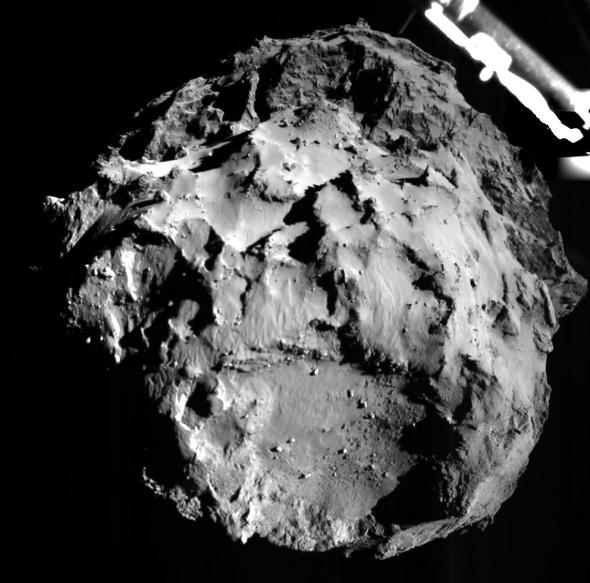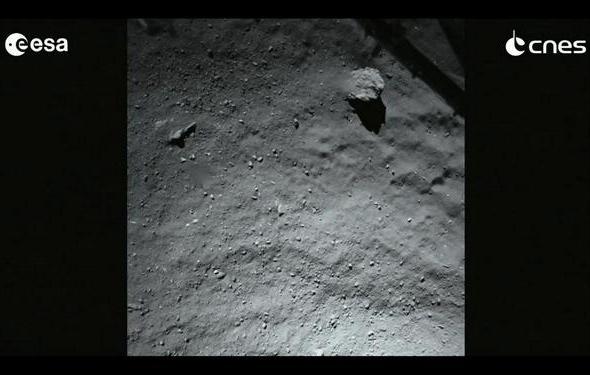Today, Nov. 12, 2014, at 16:02 UTC, a tiny robot landed gently down onto the surface of a comet.
Five hundred million kilometers away, millions of humans on Earth rode along with it.
After 10 years of travel through the depths of space, and at least that long beforehand filled with meetings, designs, construction, and a launch in 2004, the Philae spacecraft was successfully released from its Rosetta mothership. Then, seven hours later, it made history.
We have flown by eight comets before, impacted one with a 370 kilogram block of copper, and, now, for the first time ever, have landed on another. The robotic proxy of humanity sits on the surface of the comet 67P/Churyumov–Gerasimenko.

Photo by ESA Rosetta/Philae/Rolis
But only barely. For reasons yet unknown, the harpoons failed to deploy, so the lander may not be firmly anchored in place. In fact, from the telemetry received, it appears to have slowly hit the surface, bounced, spun a bit as it was over the surface (possibly due to the rotation of an internal flywheel used to change the attitude of the spacecraft), then landed again.
But it is down, and very nearly in the center of the planned target area. And if only for this reason, the mission has been a success.
It’s difficult to overstate this achievement. The comet is moving on an elliptical orbit that takes it just outside the orbit of Jupiter (850 million kilometers from the Sun) and as close as 186 million km sunward (just inside the orbit of Mars). The Rosetta spacecraft had to travel for a decade through space to catch up to its target, flying past two asteroids—Lutetia and Steins—as well as getting a gravitational boost by swinging past Mars and even Earth. It was a long, cold journey, which finally brought it alongside 67P in August 2014.
After that it slowly approached the comet, taking mapping images along the way, searching the bizarre terrain (cometain?) for a landing site. After much deliberation a suitable site was chosen. Rosetta moved in, dropped Philae, and the rest is history.

Photo by ESA/Rosetta/Philae/ROLIS via CNES
Except, again, we’re still waiting for more information. Philae is definitely down, and definitely working. It returned a few images, and engineers are still receiving telemetry from it. But it’s not clear what will happen next. The gravity on the comet is terribly weak—about 0.01 percent that of Earth—and the lander weighs half an ounce on the surface. That wouldn’t be a problem in the vacuum of space, except the comet is outgassing: The ice on and below the surface is warming as the comet approaches the Sun, and turns directly from a solid into a gas. This is a gentle wind, to be sure, but when you weigh less than a sheet of paper does on Earth, it doesn’t take much to set you flying again.
Philae has screws on the bottoms of its landing legs, and they did appear to deploy, but it’s not known how well the lander is secured. Nothing is clear right now. The European Space Agency held a press conference to give an update, but it won’t be until tomorrow that they know enough to take the next step. As soon as I know, I’ll let you know.
But, despite this sobering news, there is still joy and wonder to be had. The technical prowess to achieve this landing is nothing short of awe-inspiring. Math, science, engineering, even management and teamwork—in this case, across many countries in Europe—produced a breathtaking result: We have sent our work and our minds and our hearts across space, and done something truly remarkable.
Congratulations to ESA, to everyone involved with Rosetta, and yes, to all of us who care about exploring the Universe. It’s one of the noblest things we do.
